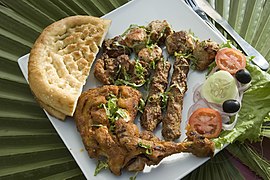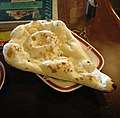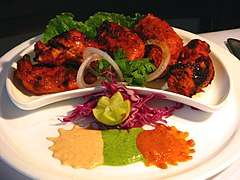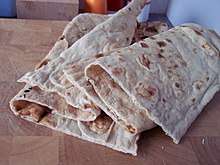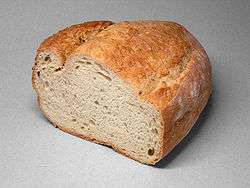Naan
Naan (Persian: نان, romanized: nān, Hindi: नान, romanized: nān) is a leavened, oven-baked flatbread[1] found in the cuisines mainly of Western Asia, South Asia, Indonesia, Myanmar and the Caribbean.[2][3][4]
 Stuffed tandoori naan | |
| Region or state | Western Asia, South Asia, Indonesia, Myanmar and the Caribbean |
|---|---|
| Serving temperature | Hot, room temperature |
| Main ingredients | Flour, yeast, salt, water |
Etymology
The earliest appearance of "naan" in English is from 1803 in a travelogue of William Tooke.[5] The Persian word nān 'bread' is attested in Middle Persian as n'n 'bread, food', which is of Iranian origin, and is a cognate with Parthian ngn, Kurdish nan, Balochi nagan, Sogdian nγn-, and Pashto nəγan 'bread'.[6] Naan may have derived from bread baked on hot pebbles in ancient Persia.[7]
The form naan has a widespread distribution, having been borrowed in a range of languages spoken in Central Asia and the Indian subcontinent, where it usually refers to a kind of flatbread (tandyr nan).[7] The spelling naan is first attested in 1979,[8] and has since become the normal English spelling.
Varieties
Western Asia
Naan as known today originates from Mesopotamia, ancient Egypt, and the Indian Subcontinent.[7] The most familiar and readily available varieties of naan in Western countries are those from the Indian subcontinent. In Iran, as well as in other West Asian nations or ethnic groups in the region, from which the word originated,[9] nân (Persian: نان) does not carry any special significance, as it is the generic word for any kind of bread.
 Nan in Iran
Nan in Iran- Nân-e barbari in Iran
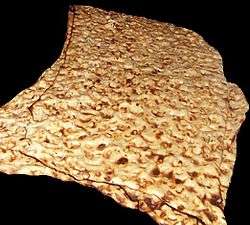 Nân-e sangak in Iran
Nân-e sangak in Iran Nân-e tâftun in Iran
Nân-e tâftun in Iran
South Asia
Naan in parts of the Indian subcontinent usually refers to a specific kind of thick flatbread (another well-known kind of flatbread is chapati). Generally, it resembles pita and, like pita bread, is usually leavened with yeast or with bread starter (leavened naan dough left over from a previous batch); unleavened dough (similar to that used for roti) is also used. Naan is cooked in a tandoor, from which tandoori cooking takes its name. This distinguishes it from roti, which is usually cooked on a flat or slightly concave iron griddle called a tava. Modern recipes sometimes substitute baking powder for the yeast. Milk or yogurt may also be used to impart distinct tastes to the naan. Milk used instead of water will, as it does for ordinary bread, yield a softer dough.[10] Also, when bread starter (which contains both yeast and lactobacilli) is used, the milk may undergo modest lactic fermentation.
Typically, it is served hot and brushed with some water but in some other cultures such as those in the Indian Subcontinent, they brush ghee or butter. It can be used to scoop other foods or served stuffed with a filling.[11]
A typical naan recipe involves mixing white or whole wheat flour with active dry yeast, salt, and water.[12] The dough is kneaded for a few minutes, then set aside to rise for a few hours. Once risen, the dough is divided into balls (about 100 g or 3.5 oz each), which are flattened and cooked. In Pakistani cuisine, naans are typically flavoured with fragrant essences, such as rose, khus (vetiver), or with butter or ghee melted on them. Nigella seeds are commonly added to naan as cooked in Indian and Bangladeshi restaurants throughout the UK.
Raisins, lentils and spices can be added. Naan can also be covered with, or serve as a wrap for, various toppings of meat, vegetables, or cheeses. This version is sometimes prepared as fast food. It can also be dipped into such soups as dal and goes well with sabzis (also known as shaakh).
Indonesia
In Indonesia, naan is popular in Indian Indonesian and Arab Indonesian community as well as Malay, Acehnese and Minangkabau–with other variant of roti like roti canai. This dish usually locally known as roti naan or roti nan and cooked using Indonesian spices, such as garlic with local taste.[13]
Myanmar
Naan bya (Burmese: နံပြား) in Burma is sometimes served at breakfast with tea or coffee. It is round, soft, and blistered, often buttered, or with pè byouk (boiled peas) on top, or dipped in thousoup (mutton soup).
Luri fiçá in Rohingya is similar to naan, but made of rice and served at festivals with beef, mutton, vegetables, and soups. It is a national cake of Rohingya in Arakan.
Naan pizza is a type of pizza where naan is used as the crust instead of the traditional pizza dough. Chefs and companies such as Nigella Lawson,[14] and Wegmans[15] offer recipes for people to make their own naan pizza at home.
| External image | |
|---|---|
 Nan in Afghanistan
Nan in Afghanistan Nan in Kabul, Afghanistan
Nan in Kabul, Afghanistan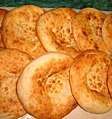 Nan in Mazar-e Sharif, Afghanistan
Nan in Mazar-e Sharif, Afghanistan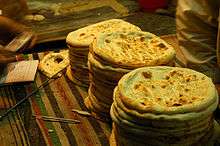
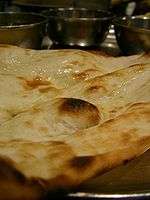 Indian naan
Indian naan Butter garlic naan
Butter garlic naan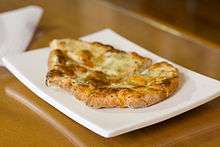 Paneer naan
Paneer naan Burmese nan bya
Burmese nan bya
See also
- Tandoor bread
- Tandoori roti
- Tandoori paratha
- Tandyr nan
- Bazlama
- Lavash
- Matnakash
- Paratha
- Parotta
- Afghan bread
- Indian breads
- Pakistani breads
- List of Pakistani breads
- List of Indian breads
References
| Wikimedia Commons has media related to Naan. |
| Wikibooks Cookbook has a recipe/module on |
- Bernard Clayton's New Complete Book of Breads By Bernard Clayton Jr., Donnie A Cameron. Simon and Schuster. 1987. ISBN 9780671602222.
- Qmin by Anil Ashokan, Greg Elms
- The Science of Cooking, Peter Barham, Springer: 2001. ISBN 978-3-540-67466-5. p. 118.
- The Bread Lover's Bread Machine Cookbook by Beth Hensperger
- Russia, or a Complete Historical Account of all the Nations which compose that Empire, London, p. 168: "The most common dishes are onoschi, or vermicelli; plav, or boiled rice; nan, pancakes, and the meats which the law permits." (referring to the eating habits of the central Turks). Other attestations in English can be found in the Oxford English Dictionary, s.v. naan.
- Manfred Mayrhofer, Etymologisches Wörterbuch des Altindoarischen, Heidelberg 1996, vol. 2, p. 6,
- Pasqualone, Antonella (2018). "Traditional flat breads spread from the Fertile Crescent: Production process and history of baking systems". Journal of Ethnic Foods. 5 (1): 10–19. doi:10.1016/j.jef.2018.02.002. ISSN 2352-6181.
- "Home : Oxford English"$ Dictionary". oed.com. Retrieved 6 September 2015.
- "Naan - Definition of naan". merriam-webster.com. Merriam-Webster. Retrieved 6 September 2015.
- Harold McGee. On Food and Cooking. Scribner. 2nd Ed, 2004.
- "The Independent - 404". The Independent. Retrieved 6 September 2015.
- "How To Make Naan Bread". videojug. Archived from the original on 10 September 2015. Retrieved 6 September 2015.
- http://www.bakingwithnyssaeda.com/2015/07/indonesian-flatbread.html
- Nigella. "NAAN PIZZA - Recipes - Nigella Lawson". nigella.com. Retrieved 6 September 2015.
- "Recipes - Wegmans". wegmans.com. Archived from the original on 1 May 2014. Retrieved 6 September 2015.
